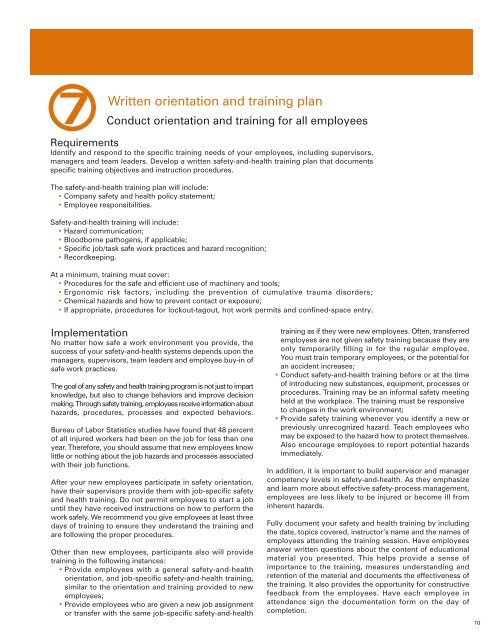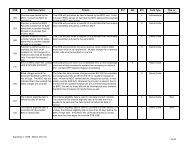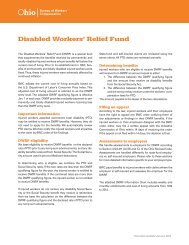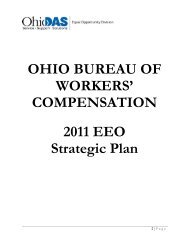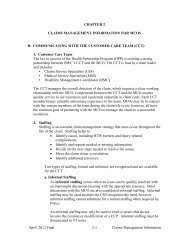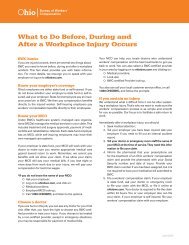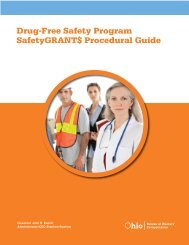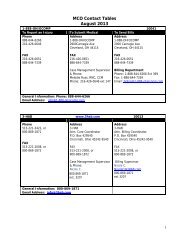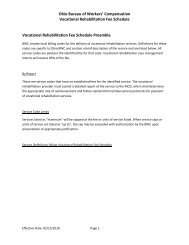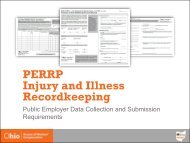BWC 10-Step Business Plan for Safety - Ohio Bureau of Workers ...
BWC 10-Step Business Plan for Safety - Ohio Bureau of Workers ...
BWC 10-Step Business Plan for Safety - Ohio Bureau of Workers ...
Create successful ePaper yourself
Turn your PDF publications into a flip-book with our unique Google optimized e-Paper software.
7<br />
Written orientation and training plan<br />
Conduct orientation and training <strong>for</strong> all employees<br />
Requirements<br />
Identify and respond to the specific training needs <strong>of</strong> your employees, including supervisors,<br />
managers and team leaders. Develop a written safety-and-health training plan that documents<br />
specific training objectives and instruction procedures.<br />
The safety-and-health training plan will include:<br />
• Company safety and health policy statement;<br />
• Employee responsibilities.<br />
<strong>Safety</strong>-and-health training will include:<br />
• Hazard communication;<br />
• Bloodborne pathogens, if applicable;<br />
• Specific job/task safe work practices and hazard recognition;<br />
• Recordkeeping.<br />
At a minimum, training must cover:<br />
• Procedures <strong>for</strong> the safe and efficient use <strong>of</strong> machinery and tools;<br />
• Ergonomic risk factors, including the prevention <strong>of</strong> cumulative trauma disorders;<br />
• Chemical hazards and how to prevent contact or exposure;<br />
• If appropriate, procedures <strong>for</strong> lockout-tagout, hot work permits and confined-space entry.<br />
Implementation<br />
No matter how safe a work environment you provide, the<br />
success <strong>of</strong> your safety-and-health systems depends upon the<br />
managers, supervisors, team leaders and employee buy-in <strong>of</strong><br />
safe work practices.<br />
The goal <strong>of</strong> any safety and health training program is not just to impart<br />
knowledge, but also to change behaviors and improve decision<br />
making. Through safety training, employees receive in<strong>for</strong>mation about<br />
hazards, procedures, processes and expected behaviors.<br />
<strong>Bureau</strong> <strong>of</strong> Labor Statistics studies have found that 48 percent<br />
<strong>of</strong> all injured workers had been on the job <strong>for</strong> less than one<br />
year. There<strong>for</strong>e, you should assume that new employees know<br />
little or nothing about the job hazards and processes associated<br />
with their job functions.<br />
After your new employees participate in safety orientation,<br />
have their supervisors provide them with job-specific safety<br />
and health training. Do not permit employees to start a job<br />
until they have received instructions on how to per<strong>for</strong>m the<br />
work safely. We recommend you give employees at least three<br />
days <strong>of</strong> training to ensure they understand the training and<br />
are following the proper procedures.<br />
Other than new employees, participants also will provide<br />
training in the following instances:<br />
• Provide employees with a general safety-and-health<br />
orientation, and job-specific safety-and-health training,<br />
similar to the orientation and training provided to new<br />
employees;<br />
• Provide employees who are given a new job assignment<br />
or transfer with the same job-specific safety-and-health<br />
training as if they were new employees. Often, transferred<br />
employees are not given safety training because they are<br />
only temporarily filling in <strong>for</strong> the regular employee.<br />
You must train temporary employees, or the potential <strong>for</strong><br />
an accident increases;<br />
• Conduct safety-and-health training be<strong>for</strong>e or at the time<br />
<strong>of</strong> introducing new substances, equipment, processes or<br />
procedures. Training may be an in<strong>for</strong>mal safety meeting<br />
held at the workplace. The training must be responsive<br />
to changes in the work environment;<br />
• Provide safety training whenever you identify a new or<br />
previously unrecognized hazard. Teach employees who<br />
may be exposed to the hazard how to protect themselves.<br />
Also encourage employees to report potential hazards<br />
immediately.<br />
In addition, it is important to build supervisor and manager<br />
competency levels in safety-and-health. As they emphasize<br />
and learn more about effective safety-process management,<br />
employees are less likely to be injured or become ill from<br />
inherent hazards.<br />
Fully document your safety and health training by including<br />
the date, topics covered, instructor’s name and the names <strong>of</strong><br />
employees attending the training session. Have employees<br />
answer written questions about the content <strong>of</strong> educational<br />
material you presented. This helps provide a sense <strong>of</strong><br />
importance to the training, measures understanding and<br />
retention <strong>of</strong> the material and documents the effectiveness <strong>of</strong><br />
the training. It also provides the opportunity <strong>for</strong> constructive<br />
feedback from the employees. Have each employee in<br />
attendance sign the documentation <strong>for</strong>m on the day <strong>of</strong><br />
completion.<br />
<strong>10</strong>


